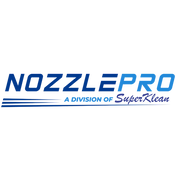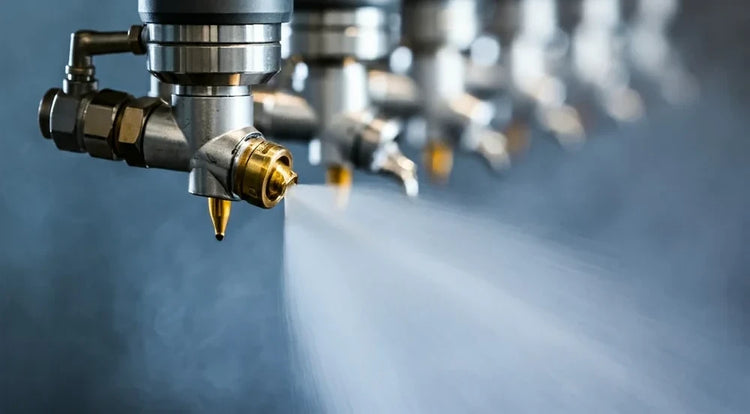The Fundamental Guide to Tank Cleaning Nozzles
Master the science and strategy of industrial tank cleaning. Learn how to select the right nozzle technology, optimize system performance, and achieve perfect cleanliness while reducing time, water, and chemical consumption.
What You'll Learn
This comprehensive resource covers everything you need to know about tank cleaning nozzle selection, technology, and optimization:
Nozzle Technology
Understand the operating principles, performance characteristics, and ideal use cases of static spray balls, rotary spray heads, and rotary jet heads.
Selection Framework
Follow our proven 4-step methodology to analyze soil classification, evaluate vessel geometry, assess system parameters, and verify compliance needs.
Industry Solutions
Discover tailored solutions for food & beverage, pharmaceutical, chemical processing, and transportation & logistics industries.
System Optimization
Learn how to maximize cleaning performance through proper system design, pump sizing, filtration, and CIP integration.
The Foundation: Sinner's Circle
At the heart of every effective cleaning operation lies the Sinner's Circle—a fundamental engineering principle that governs cleaning effectiveness. This framework identifies four interdependent factors that must work in harmony:
- Time — Duration of the cleaning cycle
- Temperature — Heat applied to the cleaning solution
- Chemical Action — Strength of cleaning agents used
- Mechanical Force — Impact energy from the nozzle spray
These elements exist in dynamic balance. Reduce one, and you must compensate by increasing one or more of the others. This is where superior nozzle technology becomes your greatest advantage.
Key Insight
The tank cleaning nozzle is the primary driver of mechanical force. Selecting the right technology allows you to dramatically reduce cleaning time by up to 85% and cut water, chemical, and energy consumption by up to 80% compared to basic alternatives.
Tank Cleaning Technology Comparison
Each nozzle technology serves a specific purpose. Understanding their strengths and limitations is essential to making the right choice:
| Feature | Static Spray Ball | Rotary Spray Head (Free-Spinning) | Rotary Jet Head (Geared) |
|---|---|---|---|
| Best For | Light soils, rinsing | Light-to-moderate soils | Heavy, stubborn, caked-on soils |
| Typical Tank Size | Small (<10 ft) | Small-to-Medium (10-30 ft) | Medium-to-Very Large (>30 ft) |
| Water/Chemical Usage | Very High | Moderate | Low |
| Cleaning Time | Long | Moderate | Short |
| Initial Cost | Low | Medium | High |
| Maintenance | Very Low (no moving parts) | Low-to-Moderate | Moderate (periodic service) |
Guide Contents
Explore each section of our comprehensive tank cleaning fundamentals guide:
I. Introduction
The core importance of tank cleanliness in industrial processing and the Sinner's Circle framework.
II. Technology Spectrum
Deep dive into static spray balls, rotary spray heads, and rotary jet heads with operational principles.
III. Selection Framework
Our proven 4-step methodology for selecting the optimal nozzle technology for your application.
IV. Industry Solutions
Tailored recommendations for food & beverage, pharmaceutical, chemical, and transportation sectors.
V. System Optimization
Complete guide to CIP systems, pump sizing, filtration, and maximizing overall performance.
VI. Partner With NozzlePro
Why NozzlePro is your ideal partner for cleaning technology and process optimization.
Industry-Specific Solutions
Each industry faces unique cleaning challenges. Our guide provides deep-dive recommendations for:
Food & Beverage Processing
Recommended Technology: Free-spinning rotary heads for general cleaning; high-impact rotary jet heads for cooked-on or stubborn residues.
Compliance: FDA-compliant materials, 3A Sanitary Standards certification
Pharmaceutical & Biotechnology
Recommended Technology: Controlled rotation rotary jet heads for precise, repeatable cleaning cycles.
Compliance: 100% self-draining, self-flushing design, validated CIP systems
Chemical & Petrochemical
Recommended Technology: High-impact rotary jet heads with specialized materials (PTFE, Hastelloy®).
Compliance: ATEX certification for explosive atmospheres, corrosion-resistant construction
Transportation & Logistics
Recommended Technology: High-impact fluid or motor-driven rotary jet heads for rapid, powerful cleaning.
Compliance: Water cannons and steam injection systems for extreme challenges
Understanding Soil Classification
The nature of the residue you need to remove is the single most important factor in selecting the right technology:
Class 1: Light Soil
Examples: Low-viscosity liquids, water-soluble powders, milk, fruit juices, spirits
- Not strongly adhered to surface
- Easy to remove with rinsing
- Minimal mechanical force needed
Recommended: Static Spray Balls or Free-Spinning Rotary Heads
Class 2: Moderate Soil
Examples: Syrups, yogurts, creams, light oils, paints, latexes
- Anchored to surface
- Requires chemical + mechanical action
- Cannot be removed by rinsing alone
Recommended: Free-Spinning Rotary Heads or Rotary Jet Heads
Class 3: Heavy Soil
Examples: Toothpaste, molasses, heavy grease, cooked-on products, hardened resins
- Viscous, sticky, hardened, caked-on
- High-impact force + extended dwell time required
- Most difficult cleaning challenge
Recommended: High-Impact Rotary Jet Heads (only automated option)
Download the Complete Guide
Get instant access to the full PDF with detailed specifications, comparison charts, and industry-specific recommendations.
Download PDF GuidePDF Format • 18 Pages • Free Resource
Frequently Asked Questions
What is the Sinner's Circle and why does it matter?
▼The Sinner's Circle is a fundamental framework in cleaning science that identifies four interdependent factors: Time, Temperature, Chemical Action, and Mechanical Force. These elements work together in dynamic balance. By optimizing nozzle selection to increase mechanical force, you can dramatically reduce cleaning time and the need for expensive chemicals and heated water.
How do I know which nozzle technology is right for my application?
▼The guide includes our proven 4-step selection framework: (1) Analyze your soil type (Class 1, 2, or 3), (2) Evaluate your vessel geometry and internal obstructions, (3) Assess your system parameters (pump capacity, drainage), and (4) Verify material and compliance requirements. This systematic approach ensures you select the optimal technology.
What are "spray shadows" and why should I care?
▼Spray shadows are areas of the tank interior that are blocked from spray impact by internal hardware like agitators, baffles, or ladders. Static spray balls are particularly prone to leaving large shadow areas, resulting in incomplete cleaning. Advanced rotary nozzles with 360-degree indexed patterns minimize this effect, though complex tanks may require multiple nozzles for 100% coverage.
Why is flow rate sometimes more important than pressure?
▼According to spray dynamics principles, doubling the flow rate can increase spray impact by up to 100%, while doubling the pressure only increases impact by approximately 40%. For tough cleaning jobs, ensuring adequate flow from a properly sized pump is often more critical than achieving extreme pressure. This insight can prevent costly system mistakes.
What industries are covered in this guide?
▼The guide provides deep-dive industry-specific sections for: Food & Beverage Processing, Pharmaceutical & Biotechnology, Chemical & Petrochemical Processing, and Transportation & Logistics (tanker trucks, rail cars, ISO tanks). Each section covers unique challenges and tailored nozzle recommendations.
Can I use the same nozzle for all my cleaning applications?
▼No. Different soil types, tank sizes, and regulatory requirements demand different technologies. Using the wrong nozzle wastes resources, extends cleaning times, and may fail to achieve required cleanliness levels. The guide's selection framework helps you identify the right technology for each specific application.

